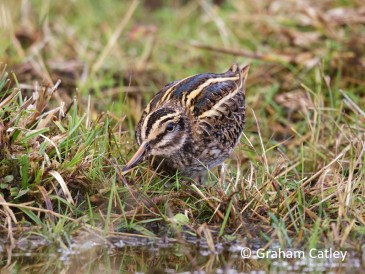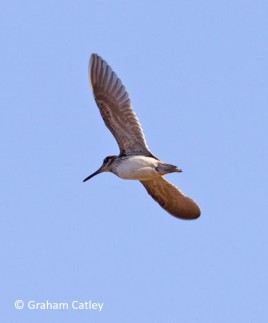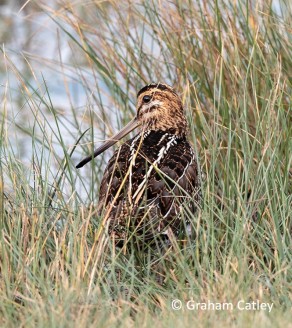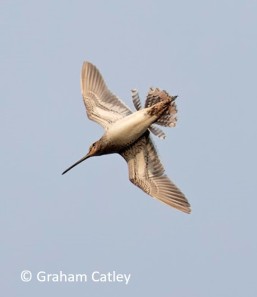Breeding Whimbrel may be associated with wet heaths but chicks need small pools and ditches too

One of the advantages for waders (shorebirds) is that parents can lead their chicks to suitable feeding areas almost as soon as they are hatched. This means that the habitat in which parents choose to secrete their nests can be very different to the habitat in which their youngsters will later forage.
 As part of a study into the potential impacts of a large wind farm proposal on Shetland, a team from Alba Ecology Ltd and Natural Research Projects Ltd collected data on the habitat associations of wader species, particularly Whimbrel, on Mainland Shetland. A paper in the BTO journal Bird Study shows that habitats used by Whimbrel chicks for feeding are significantly different to those used by adults for feeding and nesting.
As part of a study into the potential impacts of a large wind farm proposal on Shetland, a team from Alba Ecology Ltd and Natural Research Projects Ltd collected data on the habitat associations of wader species, particularly Whimbrel, on Mainland Shetland. A paper in the BTO journal Bird Study shows that habitats used by Whimbrel chicks for feeding are significantly different to those used by adults for feeding and nesting.
Fourteen sites across Mainland Shetland were studied, in order to identify the three main requirements of Whimbrel – adult territorial and foraging habitats, nest site habitats and chick feeding habitats. The sites were spread across central and west Mainland Shetland, focusing on areas regularly used by breeding Whimbrel. Between them, these held between 90 and 100 pairs, out of a local total of 150 local pairs.
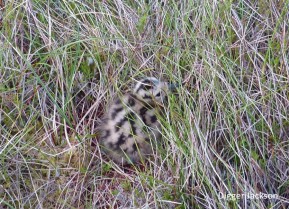 Whilst adult Whimbrels used blanket bog, dominated by ling heather, cottongrass and other species associated with wet heath, when both nesting and feeding, the structure of habitats used by chicks was very different. These were characterized by small, wet and often linear features, with plenty of mosses and plants such as purple moor-grass and bulbous rush. The presence of these flashes, ditches and former peat-cuttings may be crucial to the successful breeding of Whimbrels.
Whilst adult Whimbrels used blanket bog, dominated by ling heather, cottongrass and other species associated with wet heath, when both nesting and feeding, the structure of habitats used by chicks was very different. These were characterized by small, wet and often linear features, with plenty of mosses and plants such as purple moor-grass and bulbous rush. The presence of these flashes, ditches and former peat-cuttings may be crucial to the successful breeding of Whimbrels.
Sad times for the Curlew family

Based on IUCN BirdLife assessments
As outlined in the blog Is the Curlew really near-threatened? we have probably already lost 2 out of 8 of the members of the curlew family – definitely Eskimo Curlew and possibly Slender-billed Curlew. Although Whimbrels are not currently causing official concern, there is certainly a need to be watchful. This paper is therefore an important addition to the written information about the habitat requirements of the species. The conclusions reached by the authors may well be of interest to scientists tackling tricky issues relating to the conservation of European Curlew. Across Wales and Ireland, breeding populations have been decimated (literally).
Providing the right habitat for Shetland’s Whimbrel
For Shetland’s Whimbrel, the habitat differences between adult feeding/nesting locations and chick foraging locations were very striking and suggest that the presence of both types of habitat may be of importance. Chicks move out of the heavily grazed open heather areas, in which nests are often made, and into wetter and taller, mixed, and structurally-diverse vegetation, where it is easier to hide from predators such as gulls, corvids and skuas, and to find food. If suitable habitat for Whimbrel chick foraging is limited, then chick growth and survival may be compromised. This paper suggests that management aimed at benefiting breeding Whimbrel needs to address the habitat needs of chicks, in terms of wet features, as well as the habitat needs of adults for foraging and nesting. You can read more in the paper.

Grazed heather areas (left) are favoured by feeding and nesting adults, while chicks prefer wet flashes (right). Photos: Peter Cosgrove
Work on other upland wader species has shown that food availability, vegetation structure and cover from predators may at least partly explain habitat preferences of chicks. When tracking Golden Plover families in northern England, Mark Whittingham and colleagues found that chicks selected the edges of marshy habitats. They recommended that drainage ditches should be blocked, in order to provide more suitable feeding habitat. An added benefit of this sort of measure is that more water is held on moorland, which helps to reduce flooding downstream.

Shallow ditches increase Lapwing productivity: Mike Page/RSPB
As Peter Cosgrove, one of the authors of the new paper has commented, “The more I read and discover about wader chicks, the more I see the importance of small, wet flushes with cover – maybe this is a general feature of many species?” As you can read in A helping hand for Lapwings, the provision of wet features, particularly foot-drains, is crucial to the successful fledging of species in a more open landscape.
A matter of scale?
Creating the right habitat mosaic for adults and chicks will depend upon the scale of the movements of family parties of the wader species that is causing conservation concerns. Tómas Gunnarsson reports that family groups of Icelandic Black-tailed Godwits can cover large distances. One brood of small chicks (less than five days old) was found a week later 3 km away. Whimbrels may be able to select areas with suitable nesting and nearby chick-rearing potential or perhaps they can also move their chicks longer distances, if necessary? Research into the movements of family parties might tell us whether moving chicks for a kilometre or more could have adverse consequences, in terms of growth or survival. Presumably, adults would prefer to find the right mix of habitats within relatively close proximity, which suggests that managing grazed heath to provide a suitable mosaic of cover for nests, areas of short vegetation and wet features may be a sensible conservation prescription for Whimbrel.
WaderTales blogs are written by Graham Appleton, to celebrate waders and wader research. Many of the articles are based on previously published papers, with the aim of making wader science available to a broader audience.

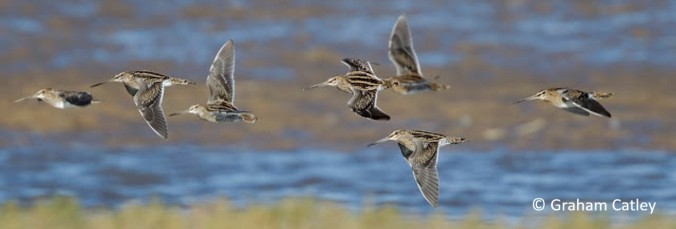
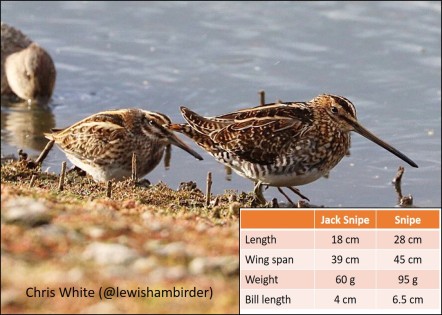 In theory, therefore, for every ten Common Snipe we see we ought to see one Jack Snipe. Telling them apart is mostly a matter of size (see table) and there’s a useful identification
In theory, therefore, for every ten Common Snipe we see we ought to see one Jack Snipe. Telling them apart is mostly a matter of size (see table) and there’s a useful identification 